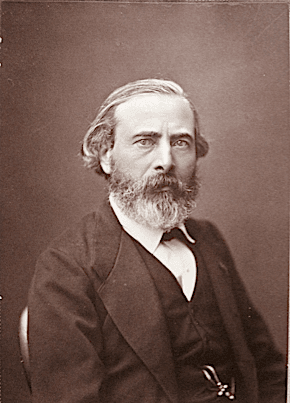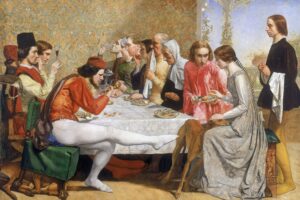A Genre Painting of Childhood Care and Quiet Work –Pierre-Édouard Frère, 1858
Painted in 1858 by French genre artist Pierre-Édouard Frère, The Little Dressmaker offers a tender glimpse into the quiet industry of childhood. Frère, beloved for his heartfelt portrayals of everyday life, invites us into a small, shadowed room where a girl, no more than ten, is hard at work. Her task is simple, but her concentration is deep—she is making a dress for her doll.
The Scene Before Us
The child sits low to the ground, turned slightly away, fully absorbed in her stitching. The light gathers softly around her hands, which hold a piece of pale pink fabric up to the doll’s tiny shoulders. On the worn chair beside her rest scraps of cloth, a thread spool, and other humble tools of her craft. An open box lies at her feet, spilling bits of colored fabric onto the floor like treasures.
There is nothing lavish here—no polished surfaces, no ornate costumes. The plaster wall is bare, the furniture plain. But everything is touched with care, both by the child’s hands and the artist’s brush.
The Deeper Meaning
This is not just a scene of a girl playing. It is a portrait of patience, intention, and tenderness. Frère knew the poetry hidden in small acts—how a child sewing for her doll reflects the gentle repetition of the adult world, how in her tiny efforts are mirrored larger ones: nurturing, providing, imagining.
She is not merely dressing a doll; she is learning how to care. The stitch she pulls is a promise: I’ll take care of you. And so we see in this quiet moment something timeless—the beginnings of responsibility, the forming of empathy, the quiet dignity of even the smallest labor.
A Moment Caught in Time
Time slows in this corner of the world. Nothing rushes the girl. She is not being watched, and yet her work is careful. The stillness hums with quiet purpose. The shadows are warm. The silence is kind. Frère has captured not just a moment of action, but a whole atmosphere—where creativity is not loud, and devotion can be found in a thread pulled gently through cotton.
About Artist

Pierre-Édouard Frère (January 10, 1819 – May 20, 1886) was a leading French genre painter known for his sympathetic and detailed depictions of everyday life, especially of children. Born in Paris, he studied at the École des Beaux-Arts under Paul Delaroche and began exhibiting at the Paris Salon in 1843. Frère spent much of his life in the village of Écouen, where he captured scenes of rural family life with warmth and humor.
Artist Style and Movement
Frère was a realist painter but often categorized under the “sympathetic art” movement in France, which portrayed the lower classes with dignity and charm rather than harsh social criticism. He focused on intimate domestic interiors, workshops, and the little pleasures and troubles of childhood, injecting humor and empathy into his narrative compositions. His style is characterized by delicate brushwork, soft lighting, and an emphasis on human emotion and character’s daily life.
Artwork Profile / Notable Works
- The Little Dressmaker: This painting epitomizes Frère’s tender and empathetic depiction of childhood, portraying a young girl concentrating on her sewing task in a humble domestic setting. It highlights the dignity and innocence of working children and captures a quiet, intimate moment.
- Going to School / Coming from School: These paired works show children in transitions of daily routine, capturing innocence and the rhythms of life in a soft, narrative manner.
- The Little Glutton: His first exhibited picture, portraying a child caught in a moment of childish indulgence, rendered with humor and charm.
- The Exercise: A painting from the John Jacob Astor collection, showcasing domestic scenes with a focus on childhood activities.
- Scenes of Rural and Peasant Life: Frère often painted genre scenes emphasizing the lives of rural families, bringing ordinary moments to art with a sense of universality and compassion.
Pierre-Édouard Frère’s genre paintings remain beloved for their sincere and dignified portrayal of daily life among children and the lower classes. His skilled craftsmanship, combined with a uniquely empathetic eye, helped him become one of the most popular and respected French painters of domestic genre scenes in the 19th century. Frère’s work offers a valuable record of a vanishing way of life infused with human warmth and humor.



